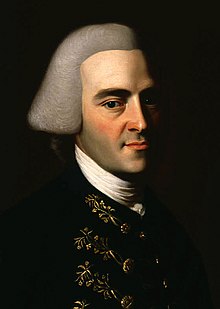
Back جون هانكوك Arabic جون هانكوك (رجال اعمال) ARZ Con Henkok Azerbaijani جان هنکاک AZB John Hancock Catalan John Hancock Czech John Hancock Danish John Hancock German John Hancock Spanish John Hancock Estonian
John Hancock | |
|---|---|
 Portrait by John Singleton Copley, c. 1770–1772 | |
| 1st and 3rd Governor of Massachusetts | |
| In office May 30, 1787 – October 8, 1793 | |
| Lieutenant | Samuel Adams |
| Preceded by | James Bowdoin |
| Succeeded by | Samuel Adams |
| In office October 25, 1780 – January 29, 1785 | |
| Lieutenant | Thomas Cushing |
| Preceded by | Office established (partly Thomas Gage as colonial governor) |
| Succeeded by | James Bowdoin |
| 4th and 13th President of the Continental Congress | |
| In office November 23, 1785 – June 5, 1786 | |
| Preceded by | Richard Henry Lee |
| Succeeded by | Nathaniel Gorham |
| In office May 24, 1775 – October 31, 1777 | |
| Preceded by | Peyton Randolph |
| Succeeded by | Henry Laurens |
| 1st President of Massachusetts Provincial Congress | |
| In office October 7, 1774 – May 2, 1775 | |
| Preceded by | Office established |
| Succeeded by | Joseph Warren |
| Personal details | |
| Born | January 23, 1737 Braintree, Province of Massachusetts Bay, British America (now Quincy) |
| Died | October 8, 1793 (aged 56) Hancock Manor, Boston, Massachusetts, U.S. |
| Resting place | Granary Burying Ground, Boston |
| Spouse | |
| Children | 2 |
| Relatives | Quincy political family |
| Alma mater | Harvard University |
| Signature | |
John Hancock (January 23, 1737 [O.S. January 12, 1736] – October 8, 1793) was an American Founding Father, merchant, statesman, and prominent Patriot of the American Revolution.[1] He was the longest-serving president of the Continental Congress, having served as the second president of the Second Continental Congress and the seventh president of the Congress of the Confederation. He was the first and third governor of the Commonwealth of Massachusetts. He is remembered for his large and stylish signature on the United States Declaration of Independence, so much so that in the United States, John Hancock or Hancock has become a colloquialism for a person's signature.[2] He also signed the Articles of Confederation, and used his influence to ensure that Massachusetts ratified the United States Constitution in 1788.
Before the American Revolution, Hancock was one of the wealthiest men in the Thirteen Colonies, having inherited a profitable mercantile business from his uncle. He began his political career in Boston as a protégé of Samuel Adams, an influential local politician, though the two men later became estranged. Hancock used his wealth to support the colonial cause as tensions increased between colonists and Great Britain in the 1760s. He became very popular in Massachusetts, especially after British officials seized his sloop Liberty in 1768 and charged him with smuggling. Those charges were eventually dropped; he has often been described as a smuggler in historical accounts, but the accuracy of this characterization has been questioned.
- ^ Bernstein, Richard B. (2009). "Appendix: The Founding Fathers, A Partial List". The Founding Fathers Reconsidered. New York: Oxford University Press. pp. 176–180. ISBN 978-0199832576.
- ^ Harlow G. Unger (September 21, 2000). John Hancock: Merchant King and American Patriot. Wiley. ISBN 978-0-471-33209-1.